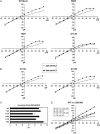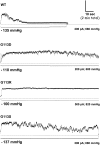Pore mutations of the Escherichia coli MscS channel affect desensitization but not ionic preference
- PMID: 18065458
- PMCID: PMC2275705
- DOI: 10.1529/biophysj.107.123448
Pore mutations of the Escherichia coli MscS channel affect desensitization but not ionic preference
Abstract
Mechanosensitive channels rescue bacterial cells from a fate of lysis when they transfer from a high- to low-osmolarity environment. Of three Escherichia coli mechanosensitive proteins studied to date, only MscS-Ec demonstrates a small anionic preference and a desensitized, nonconducting state under sustained pressure. Little is known about the mechanisms generating these distinctive properties. Eliminating the sole positive charge in the MscS-Ec pore region (Arg(88)) did not alter anionic preference. Adding positive charges at either end of the pore did not augment anionic preference, and placing negative charges within the pore did not diminish it. Thus, pore charges do not control this characteristic. However, from this analysis we identified mutations in the hinge region of the MscS-Ec pore helix (at Gly(113)) that profoundly affected ability of the channel to desensitize. Substitution with nonpolar (Ala, Pro) or polar (Asp, Arg, Ser) residues inhibited transition to the desensitized state. Interestingly, Gly(113) replaced with Met did not impede desensitization. Thus, although Gly is not specifically required at position 113, MscS desensitization is strongly influenced by the residue situated here. Mutations at residues further into the pore also regulated desensitization. Transition to this unique mechanosensitive channel state is discussed in terms of existing data.
Figures






References
-
- Berrier, C., A. Coulombe, C. Houssin, and A. Ghazi. 1989. A patch-clamp study of ion channels of inner and outer membranes and of contact zones of E. coli, fused into giant liposomes. FEBS Lett. 259:27–32. - PubMed
-
- Blount, P., S. I. Sukharev, P. C. Moe, S. K. Nagle, and C. Kung. 1996. Towards an understanding of the structural and functional properties of MscL, a mechanosensitive channel in bacteria. Biol. Cell. 87:1–8. - PubMed
-
- Moe, P. C., P. Blount, and C. Kung. 1998. Functional and structural conservation in the mechanosensitive channel MscL implicates elements crucial for mechanosensation. Mol. Microbiol. 28:583–592. - PubMed
Publication types
MeSH terms
Substances
Grants and funding
LinkOut - more resources
Full Text Sources
Miscellaneous

